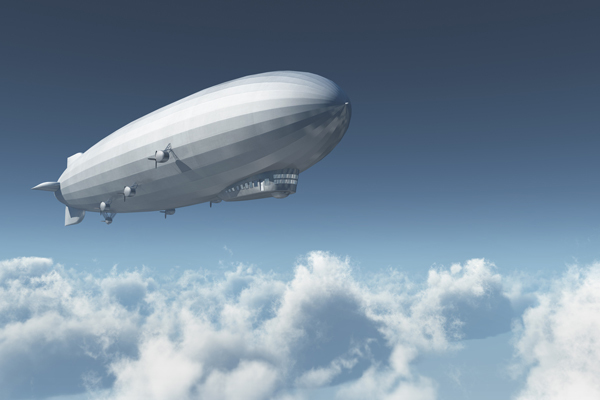
Come fly with me
Financial Post: Forget the Hindenburg!
The following is an op-ed written by Barry Prentice, a professor of supply chain management in the Asper School of Business. It was originally published on Sept. 30, 2020, in the Financial Post.
Hydrogen is not just the transportation fuel of the future: it is here now. Hydrogen gas is already used to power road vehicles (cars, trucks, buses), fork-lift trucks and even, in Germany, trains. Aviation is the next mode of transport converting to hydrogen. Hydrogen-using airplanes are still some ways off. But safe and cost-effective hydrogen airships could be flying now, if only our air regulations allowed it.
Earlier this month, the first International Hydrogen Aviation Conference (IHAC), originally scheduled for Scotland but moved to Zoom because of the pandemic, brought together experts on hydrogen-powered airplanes, hydrogen storage systems and electric airships.
The development of electric aircraft has been underway for some time. Electric motors have already been certified for aviation use, while prototypes have been flown using lithium-ion batteries and hydrogen fuel cells (HFCs). The obvious challenges for electric airplanes are the weight and space required to store sufficient energy.

Hydrogen, in this “solar system” model, is straightforward and powerful. Per kilogram, it has 10 times the energy density of batteries. // Image: Wikipedia, CC BY-SA 4.0
Hydrogen is a winner in energy terms. Per kilogram, it has 10 times the energy density of batteries. But a hydrogen airplane must also accommodate storage tanks and the fuel cell. Hydrogen must be cryogenically liquified (to -263°C) and stored in vacuum-insulated containment vessels to provide enough fuel for jet airplanes. Regular jet fuel is held in a plane’s wings, but the size and shape of hydrogen fuel tanks require them to be stowed in the fuselage. Retrofitting existing aircraft is expensive, the supply chain for liquid hydrogen is embryonic, and refuelling at airports has yet to be worked out. So, don’t expect to fly on a hydrogen-powered jet anytime soon.
Airships powered and lifted by hydrogen are a different matter, as presentations by airship companies representing France, Israel, the U.S. and Canada made clear at IHAC. Unlike airplanes, dirigibles do not need liquid hydrogen. They are so big they can stow pressurized hydrogen gas tanks without impinging on the space required for cargo or passengers. All four airship companies plan to use hydrogen-fuelled craft and electric motors to deliver zero-carbon emissions transport.
Although aviation regulators seem content with the use of hydrogen in all forms of transport, there is one anomaly — using hydrogen gas to inflate airships. Canadian Air Regulation 541.7 states: “Hydrogen is not an acceptable lifting gas for use in airships.” A ban on this one use of hydrogen is strange, given that Canada has never had an airship industry. The ban’s origins are even more surprising.
In 1922, officials from the U.S. Bureau of Mines, trying to protect a newly established helium refinery, staged a fraudulent demonstration in Washington. They showed that a helium-filled toy balloon will not ignite. Pure hydrogen will not burn either, but if the gas is contaminated by more than 25 per cent air, it can. Their contaminated hydrogen balloon created a bang that rattled the windows of Congress. Based on nothing more, U.S. politicians banned hydrogen’s use in airships. Other countries ignored the U.S. prohibition, however. In 1930, the hydrogen-filled, British-built R100 airship, known as the “Emperor of Canada,” flew here and hundreds of thousands of people lined up to see it in Montreal, Ottawa, Toronto and Niagara Falls.
“Prime Minister Trudeau, you were brave enough to end the ban on cannabis. It is time to end the fraudulently induced ban on the use of hydrogen gas in airships and set this technology free.”
The fiery Hindenburg accident in Lakehurst, N.J., in May 1937 is often considered to have rung the death knell for hydrogen-filled airships, but research shows that the craft’s flammable envelope was really to blame. With 21st-century materials and engineering, a modern hydrogen dirigible would be as safe as any modern airplane. Still, after World War II, when the U.S. was the dominant world air power, its regulations were rubber-stamped into the laws of most other nations, including Canada’s. Thus did Canada come to ban this single use of hydrogen as a lifting gas in airships — not because of engineering research but because of a political decision made in a foreign country, 98 years ago, at the behest of dishonest lobbyists.
If hydrogen gas in a pressurized tank is considered safe for powering airplanes, why is the same hydrogen in a non-pressurized containment vessel not safe for lifting airships? This prohibition on hydrogen has held back research and created doubts about the economic viability of airships, which have been forced to depend instead on increasingly scarce supplies of helium.
Canada needs cargo airships to provide lower-cost, year-round transport to the North, especially if warmer temperatures come to play havoc with the winter road system. Airships could well do for the Northern economy what railways did for Western Canada 125 years ago. Prime Minister Trudeau, you were brave enough to end the ban on cannabis. It is time to end the fraudulently induced ban on the use of hydrogen gas in airships and set this technology free.







A small but important criticism.
“…research shows that the craft’s flammable envelope was really to blame.”
No, it does not. As a matter of fact, research proves the opposite – the outer covering of the ship, along with the doping compound applied thereto, was neither exceptionally flammable nor the primary accelerant of the fire. Large quantities of the fabric survived both the destruction of the ship which, yes, was the product of a large hydrogen conflagration, and the diesel fires that persisted for hours thereafter.
The latter fire was caused by the fuel tanks that supplied the ship’s DB-602 engines, while the former was, in all likelihood, caused by a quantity of hydrogen which had mixed with the ship’s oxygen environment, likely because of a gas cell ruptured by a failed tensioning cable, followed by a static spark transmitted from the relatively nonconductive fabric covering to the duralumin framework following the dropping of the ship’s mooring lines. Compounding the unlikelihood of the cover playing any significant role in the fire is the fact that the covering of the next ship, LZ-130, an improved iteration of the Hindenburg-class design, was only changed to make its upper third more conductive, minimizing the chance of static sparking. Apart from this change, the supposedly “explosive”/”rocket-fuel”/what-have-you doping compound was unchanged.
You must remember that the Germans were masters of controlling hydrogen in their airships, a very flammable gas . All their airships used hydrogen to lift their airships. The US had a monopoly on helium and the Helium Act forbid any helium leaving this country. So with all their airships using hydrogen and the Hindenburg making 55 total flights in 1936 and the Graf Zeppelin having a flawless career for 9 years, yes the Germans did extremely well. The Graf Zeppelin flew around the world in 1929 using hydrogen as the gas to lift the airship.
The German track record for using hydrogen in their airships was stellar. The Hindenburg made 55 flights in 1936 using hydrogen for lifting purposes and the Graf Zeppelin essentially flew flawlessly for over 9 years using hydrogen gas , including a trip around the world in 1929.
What about bad winds and harsh weather?